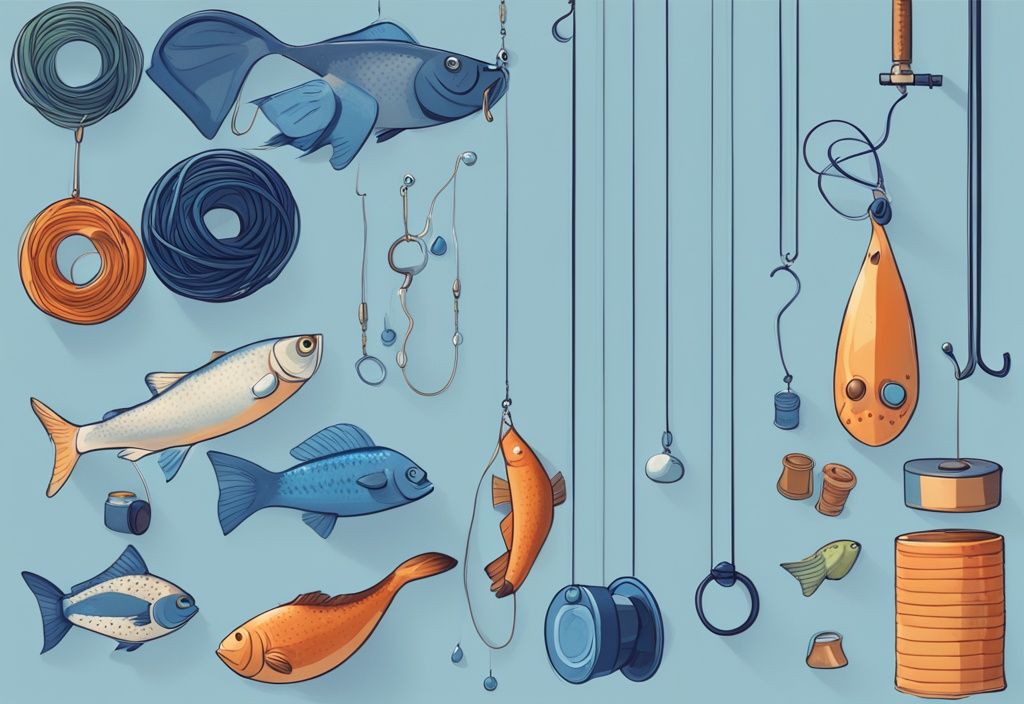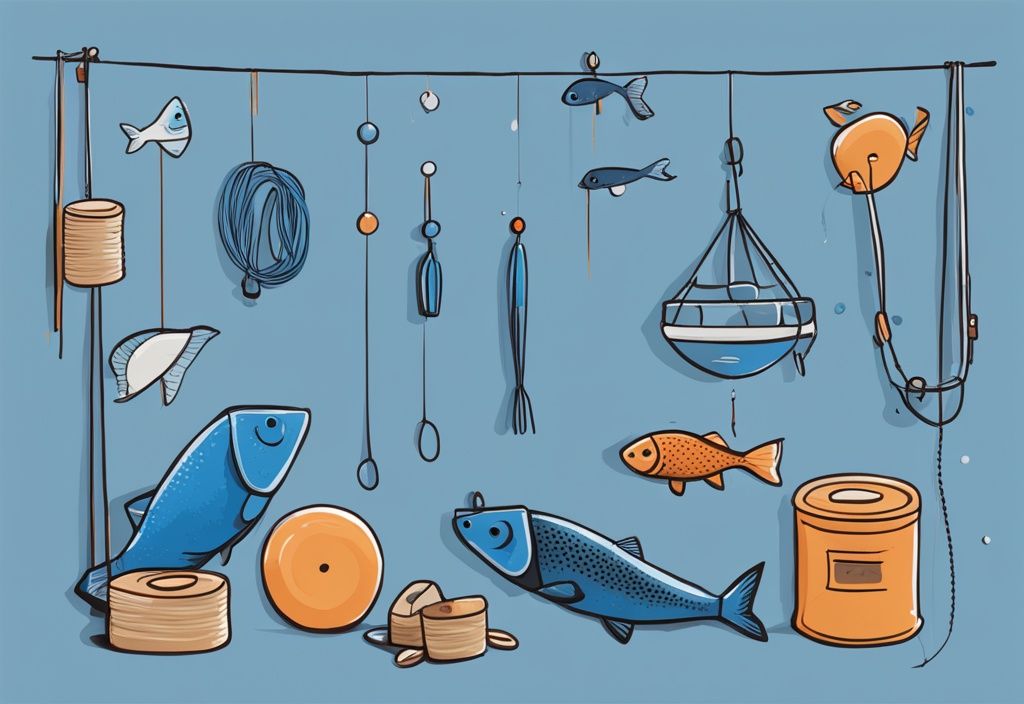Who hasn’t felt the snap of a fishing line just as the big catch was within reach? Hi, I’m Jake Marlin, and I’ve been there too. Over the past two decades, I’ve fished the length and breadth of this great country, and learnt a thing or two about the importance of understanding the weight your fishing line can hold.
In this article, we’re diving straight into the heart of that question. We’ll unearth the ins and outs of what influences the weight your fishing line can handle, from the type of material to the diameter and the strength of the knot you’re using. I’ll share tips that’ll help you choose the perfect line for different fish and conditions.
So, are you ready to make sure your next big catch doesn’t slip away because of a faulty line? Let’s get started.
Factors Determining the Weight Capacity of Fishing Line
Understanding how much weight a fishing line can hold is critical for any angler looking to optimize their fishing experience. Various factors play a role in determining this weight capacity, including line material and construction, line diameter, knot strength and type, and the wear and tear the line experiences over time. To choose the right fishing line, it’s essential to know how each of these elements affects the line’s overall capacity to support weight.
Understanding Line Material and Construction
The material and construction of a fishing line are fundamental in determining how much weight it can hold. There are three primary types of fishing lines: monofilament, braided, and fluorocarbon, which you can learn more about in detail at Take Me Fishing. Each has specific attributes affecting their strength and suitability for particular fishing conditions.
- Monofilament Lines: Known for versatility, these lines typically range from 1lb to 100lb test. They offer a balance of strength and stretch, making them ideal for various fishing scenarios.
- Braided Lines: These lines boast a high strength-to-diameter ratio, supporting weights from 5lb to over 200lb. Made from ultra-high-molecular-weight polyethylene fibers, they provide exceptional durability and minimal stretch.
- Fluorocarbon Lines: Valued for their near invisibility underwater and high abrasion resistance, fluorocarbon lines range from 2lb to 200lb in strength. They are particularly useful in clear water and rocky environments.
The Impact of Line Diameter on Weight Capacity
One might wonder, how much weight can a fishing line hold based on its diameter? Generally, thicker lines can support more weight. However, the diameter also influences other factors such as casting distance and the line’s visibility underwater. Balancing line diameter with other characteristics like material type and fishing conditions is crucial to ensure optimal performance and strength.
Knot Strength and Type: Do They Matter?
Knot strength is a critical yet often overlooked factor affecting a fishing line’s weight capacity. Improperly tied knots or unsuitable knot types can reduce a line’s strength by as much as 50%. To preserve the line’s weight capacity, anglers should utilize knots known for their reliability, such as the Palomar knot, improved clinch knot, and double uni knot. These knots are designed to maintain line integrity and ensure it can hold its maximum possible weight.
What Effects Does Wear and Tear Have Over Time?
Wear and tear is an inevitable part of any fishing line’s life cycle, significantly impacting how much weight it can hold over time. Exposure to sunlight, varying water conditions, and repeated use can degrade the line. This degradation manifests as frayed or worn sections, substantially reducing the line’s original strength. Regular inspections for any signs of wear and prompt replacement of compromised sections, or the entire line, are vital practices to maintain its weight capacity and ensure successful fishing trips.
What is Pound Test and Why Does it Matter?
The pound test, often abbreviated as lb test, signifies the number you see on the spool of fishing line at your local tackle shop. It’s the maximum weight that line can hold before it snaps, and trust me, it’s a big deal in the fishing world. Imagine this: You’re out on the water and you hook into a monster fish. Without the right pound test, that dream catch could be history in seconds.
For example, an 8lb test line can support an eight-pound weight, such as a cinder block, but it would break if loaded with a nine-pound block. Understanding the pound test means you’re better equipped to handle the conditions of your fishing spot and the size of the fish you’re eyeing to catch. Simple, right? Yet, absolutely crucial.
Selecting the Right Pound Test for Your Fishing Style
Choosing the correct pound test depends on several factors, including the size of the fish, the environment, and the angling techniques you plan to use. Let’s break it down:
- Light Lines (1-6 lbs): Perfect for small freshwater fish like trout and bluegill. They excel in scenarios where you need high sensitivity to detect those subtle nibbles. Ever tried fly fishing in a quiet stream? That’s where light lines shine.
- Medium Lines (8-20 lbs): Your go-to for moderately sized fish such as bass and catfish. These lines are super versatile and can be used in both freshwater and light saltwater conditions. Finding a balance is key here, and medium lines often hit that sweet spot.
- Heavy Lines (25-50 lbs): Built to wrestle bigger fish like salmon and steelhead. They come into their own in tougher conditions where durability and strength are non-negotiable. Picture yourself battling a feisty salmon on a cold, misty river—heavy lines are your ally.
- Ultra-Heavy-Duty Lines (65-250 lbs): When you’re out to tame the legends of the sea, like marlin and sharks, these lines are essential. Deep-sea fishing demands reliability and sheer muscle, and ultra-heavy-duty lines deliver just that. Imagine the thrill of a deep-sea tussle; you’d want nothing but the best, right?

When you’re selecting the pound test for your fishing line, consider not only the size of the fish but also the specific fishing environment and techniques you plan to employ. Getting the right pound test can make all the difference in your fishing success and overall experience.
Detailed Look at Different Fishing Line’s Weight Capacity
Fishing lines come in various shapes and strengths, tailored to meet diverse angling needs. Let’s explore the weight capacities of different types of fishing lines and understand their unique characteristics.
Unraveling the Strength of Monofilament Fishing Line
Monofilament fishing lines are the jack-of-all-trades in the angling world. With their flexibility and adaptability, these lines are perfect for a plethora of fishing conditions and species. Their strength can vary from as light as 1lb to as hefty as 100lb test. It’s all about balancing what you need—are you casting light in clear waters, or are you gunning for the big one in deeper, murky spots?
Monofilament’s single-strand nature makes knot tying a breeze, a crucial factor when pondering how much weight can fishing line hold. But remember, the thicker the line, the shorter the cast, and the more visible it becomes underwater. So, choose wisely based on your fishing environment and target fish.
Deconstructing the Power of Braided Fishing Lines
Braided lines are the muscle builders of the fishing line world. Made from Ultra-High Molecular Weight Polyethylene fibers, these lines pack a punch with incredible strength and durability. Think of them as the Spider-Man of lines, able to handle weights from 5lb all the way to a whopping 200lb!
With their high strength-to-diameter ratio, braided lines can cast farther and offer superior sensitivity. This makes them a top pick for those aiming to reel in larger, more robust fish. Minimal stretch means you’ll feel every nibble and set that hook like a pro. Yet, mastering knot techniques with braided line is essential—it’s a bit trickier to secure compared to other types. When it comes to how much weight can fishing line hold, braided lines are in a league of their own, withstanding heavy loads without breaking a sweat. If you’re new to fishing terminology, you might wonder what does PB mean in fishing, which is another important aspect to understand for enthusiasts.
Evaluating the Capability of Fluorocarbon Fishing Lines
Fluorocarbon lines are the stealth operators of the fishing world. Their almost invisible presence underwater and remarkable durability make them a go-to for many anglers. Ranging from 2lb to 200lb in strength, fluorocarbon lines cater to a wide array of fishing scenarios.
Their high abrasion resistance is unbeatable for rocky or debris-filled environments where other lines might fray. And with a denser material, these lines sink faster—perfect for getting your bait where it needs to be. Considering how much weight can fishing line hold is crucial, and fluorocarbon delivers with robust strength that stays hidden from even the most discerning fish. They’re the secret weapon in any angler’s arsenal!pheric
How The Weight Capacity of Different Fishing Lines Compares
As any seasoned angler can tell you, the weight capacity of a fishing line is crucial for ensuring you’ve got the right tools for the job. Let’s dive into the specifics of how much weight different types of fishing lines can hold, and what that means for your next outing.
Weight Capacity of Light Fishing Lines (1-6 lbs)
Light fishing lines, ranging from 1 to 6 pounds, are ideal for those delicate operations when you’re after small freshwater fish like trout or bluegill. These lines are your go-to for finesse, sensitivity, and precision. Picture this: you’re along a serene stream, the sun’s just right, and you feel the faintest nibble—light lines let you react instantly. Despite their lower weight capacity, they offer precise control, which is a game-changer when trying to outsmart those wary fish.
There’s a certain art to maneuvering these lines; it’s almost like dancing. The subtlety they afford is essential in ensuring you don’t spook the fish, making your fishing experience much more rewarding.
What Can Medium Fishing Lines (8-20 lbs) Hold?
Medium fishing lines, with capacities spanning from 8 to 20 pounds, are your versatile workhorses. They’re perfect for targeting moderate-sized fish like bass or catfish. These lines balance strength and flexibility, suitable for an array of environments, from freshwater lakes to light saltwater excursions.
Take a moment to think about it: you’re out on the water, the line goes taut, and you feel that satisfying pull. Medium lines can handle varying conditions without compromising performance, giving you peace of mind whether you’re bass fishing in a familiar pond or exploring saltwater spots. They’re the jack-of-all-trades in your tackle box, prized for their adaptability and reliability.
How Much Weight Heavy-Duty Fishing Lines (25-50 lbs) Can Withstand
Now, let’s talk about heavy-duty fishing lines, which boast weight capacities from 25 to 50 pounds. These lines are engineered for the big leagues—think salmon and steelhead. Built for tougher conditions, heavy-duty lines excel in withstanding powerful pulls and harsher environments.
Imagine gearing up for an intense river fishing adventure or deep-water trolling. The resilience and durability of these lines ensure you can tackle challenging scenarios without fearing a line break. They’re your best bet when you need robust performance and dependability, especially in tougher terrains.
The Strength of Ultra Heavy-Duty Lines (65-250 lbs)
When it comes to ultra heavy-duty fishing lines, ranging from 65 to a whopping 250 pounds, you’re entering the realm of the giants—marlin, sharks, and other massive predators. Perfect for deep-sea fishing, these lines are designed to handle the ultimate test in strength and endurance.

Picture this: the ocean’s vast expanse, the adrenaline rush as you feel that massive hit on your line. With these ultra heavy-duty lines, you can take on colossal challenges with confidence. Their unparalleled strength and toughness make them indispensable when you’re out for battle against the mightiest of fish.
Understanding the weight capacities of various fishing lines helps you choose the right gear for your specific needs, ensuring every fishing trip is as successful and enjoyable as possible.
What Role Does Fishing Environment Play on Line’s Weight Capacity?
Fishing environments vary widely, and their unique characteristics can dramatically affect how much weight a fishing line can hold. Let’s dive into some of the key environmental factors that influence line strength.
The Impact of Water Depth and Clarity on Fishing Line Strength
The fishing environment significantly influences the effectiveness and endurance of your fishing line, particularly in terms of water depth and clarity. When you’re casting in deeper waters, the increased pressure necessitates a line that boasts superior strength. Deeper waters often bring stronger currents and hidden obstacles that can seriously test a line’s durability and weight capacity. Imagine battling both the depth and the unseen snags below—this is where lines with high tension resistance and abrasion resistance become your best allies.
Now, picture casting in crystal-clear water. Here, the visibility of your line can make or break your day. Fish in such environments are quite wary, which is why fluorocarbon lines—known for their near invisibility underwater—become the secret weapon. These lines not only keep your bait stealthy but also offer the durability needed to handle the weight and power of those fish, whether you’re in clear or deep waters.
How Temperature Influences Line’s Performance
Temperature variations play a big role in the physical properties of fishing lines, directly impacting their performance and their capacity to hold weight. Picture a chilly morning on the lake: in colder temperatures, fishing lines—especially monofilament—can become brittle. This brittleness reduces flexibility and makes the line more prone to fractures or breaks under less strain than you’d usually expect. So, when the mercury drops, opting for thicker, more robust lines ensures your line retains its strength and weight capacity.
On the flip side, blazing hot conditions can wreak havoc on the molecular structure of your line, particularly those made from monofilament and fluorocarbon. Heat makes these lines stretch and lose tensile strength, increasing the risk of snapping under pressure. To combat the heat’s effects, braided lines are a smart choice in warmer conditions due to their higher heat resistance. Also, storing your lines properly to avoid prolonged exposure to extreme temperatures can go a long way in preserving their weight-holding efficiency.
With these insights, you’re well-equipped to choose the right line for any fishing environment, ensuring your setup can take the weight—whether you’re in the deepest depths or under the blazing sun.
The Influence of Fishing Equipment on Line Weight Capacity
Every piece of fishing gear has its role when it comes to understanding just how much weight a fishing line can hold. It’s like a well-orchestrated dance where each component—rods, reels, and even the drag system—needs to hit the right note for success. Let’s delve into the intricacies of this dance.
Balancing Line Weight Capacity with Rod and Reel
Matching the line strength with your rod and reel specifications is crucial for balanced performance.
Rods and reels are designed to handle a specific range of line weights, typically indicated on the equipment.
Using a line that exceeds these recommendations can lead to inefficient casting, reduced sensitivity, or even equipment failure under stress.
Imagine the frustration of having your rod rated for a 10-20lb line, but using a 25lb line instead. That situation might result in undue strain, potentially snapping your precious gear! On the flip side, opting for a line that’s too light can mean heartbreak when you lose a fish due to inadequate strength.
Properly matched equipment maximizes the capabilities and longevity of your gear while ensuring an optimal fishing experience. Balance is key, and so is following those recommended specs on your gear.
The Contribution of Drag System
The drag system in a reel plays a pivotal role in managing the force exerted by a hooked fish, significantly influencing how much weight a fishing line can hold.
A well-set drag can transform a daunting fishing day into a triumphant one. When set correctly, the drag system allows the line to give way under pressure, preventing those sudden, heart-stopping snaps when force is too intense. This becomes particularly important when you’re using lighter lines.
Think of the drag system like a shock absorber, absorbing strain and distributing it evenly across the fishing line.
It means you can go for those heavier fish even with a lighter line, turning every cast into a promising adventure without the worry of snapping. Proper drag management is a game-changer, making your fishing endeavors not only more successful but also more enjoyable.
Keeping Your Line at Peak Performance: Maintenance Tips
To truly understand how much weight can fishing line hold, maintaining your gear is paramount. Regular maintenance practices are not just preventative but essential for ensuring the line’s strength and durability.

The Importance of Regular Line Inspection and Maintenance
We all know the frustration of losing a catch due to a failed fishing line. Regular inspection of your line is more than just a good habit—it’s a crucial step. Periodically run your fingers along the line to feel for nicks, frays, or any damage. These tiny imperfections can significantly weaken the line and reduce how much weight it can hold. By addressing these issues promptly and replacing damaged sections or the whole line if necessary, you ensure that your line retains its designated strength. It’s this attention to detail that keeps your fishing adventures smooth and successful.
Extending Line Life through Best Practices
Incorporating best practices into your routine can considerably extend the life of your fishing line. Store your lines in a cool, dry place, away from direct sunlight and extreme temperatures. UV rays and heat can degrade the material of the line, impacting its ability to hold weight. After every saltwater fishing trip, make it a habit to rinse your line with fresh water. This simple yet effective step removes corrosive salt residue that can weaken the line over time. By following these practices, you not only understand how much weight can fishing line hold but also ensure your line performs optimally when it matters most.
Proper Knot Tying Techniques to Enhance Weight Capacity
Ever lost a fish because of a poorly tied knot? Trust me, I have. Using proper knot-tying techniques is essential for maximizing the weight your fishing line can handle. Strong, reliable knots like the Palomar knot can dramatically enhance your line’s capacity. On the other hand, a poorly tied knot can reduce the line’s strength by up to 50%, severely impacting its performance. Practice makes perfect, so invest some time into mastering these knots. By doing so, your line will maintain its full strength, and you’ll fish with greater confidence and success.
Conclusion
To truly grasp how much weight a fishing line can hold, let’s dive into the core factors that determine its strength. First off, the line material is crucial. Monofilament, braided, and fluorocarbon lines each bring unique benefits and strength ranges, helping anglers make informed choices based on fishing conditions. Think of monofilament as your all-rounder, braided lines with their impressive strength-to-diameter ratio, and fluorocarbon lines which are virtually invisible underwater and extremely durable.
Then we have the line diameter, a key player in weight capacity, casting distance, and visibility underwater. A thicker line usually means more weight support, but it might cut down on casting distance and could be more noticeable to fish. Striking the right balance between diameter and other line properties is essential for top-notch performance. And don’t forget the knots; they’re the unsung heroes in this saga. Knots like the Palomar knot or the improved clinch knot can significantly bolster the overall strength of your fishing line, preserving its integrity and maximizing weight capacity.
The battle doesn’t stop there. Wear and tear will inevitably challenge your line. Factors like sunlight, water conditions, and routine use can degrade it over time. Regular inspections and swift replacements at the first sign of damage are crucial for keeping your line strong. Proper storage and best practices—like rinsing lines post-saltwater adventures and avoiding direct sunlight—can extend your line’s lifespan.
Next up, understanding pound test ratings is key to figuring out how much weight your fishing line can hold. This rating tells you the maximum weight the line can handle before it snaps. It’s your guide to choosing lines that match your target fish and fishing style. Light lines work great for small freshwater fish like trout, while heavy-duty lines are your allies against bigger species like salmon or even sharks in the heavier categories.
Finally, the fishing environment and your gear play pivotal roles. Water depth, clarity, and temperature can all influence the required line strength and performance. Matching the line’s weight capacity with your rod and reel specifications ensures a balanced, efficient setup. The drag system on your reel also plays a part, helping lighter lines manage heavier catches when configured correctly.
In summary, optimizing your fishing line’s weight capacity requires a holistic approach that covers careful selection, proper technique, and diligent maintenance. Aligning these elements with your gear and fishing environment can significantly enhance your angling experience, making sure you’re ready to land your dream catch, come what may.
Frequently Asked Questions
Fishing line selection can make or break your day out on the water. Here, we dive into the nitty-gritty of how much weight fishing line can hold and related factors to help you make the best choice for your next adventure.
What is the pound test on a fishing line?
The pound test is the magic number every angler looks for—it’s like the heartbeat of your line. Simply put, it indicates the maximum weight the line can handle before it gives up. Knowing your pound test means you can confidently tackle the fish you’re chasing, whether it’s a nimble trout or a stubborn bass.
How do I select the appropriate pound test for my needs?
Tailoring your line to your fishing scenario is crucial. Are you aiming for small, delicate fish in calm waters? Then a lightweight line might be your best friend. But if you’re gearing up for a battle with a hefty catfish in murky conditions, you’ll want something sturdier. Always think about the fish size, your fishing technique, and the environment you’ll be navigating.
Does the fishing line diameter affect its weight capacity?
Absolutely, it does. A thicker line can be a powerhouse, holding more weight and offering extra strength when things get rough. However, there’s a trade-off—you might find it affects your casting distance and how visible the line is underwater. It’s a balancing act, but one that’s worth mastering.
When should I replace my fishing line?
Inspect your line like an old friend. If you spot fraying, nicks, or if it’s been through a grueling season, it’s time to swap it out. Fresh line ensures that when that big moment comes, your gear won’t let you down. Regular checks keep your setup reliable and your adventures worry-free.
Can I catch heavier fish with a lighter line using the right technique?
Without a doubt. Master the art of line management and drag settings, and you can land heavier fish with finesse. That lighter line might feel like a whisper in the water, but with skillful handling, you can turn the odds in your favor. It’s all about playing it smart and keeping your cool during the fight.


